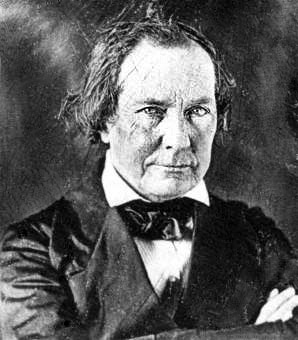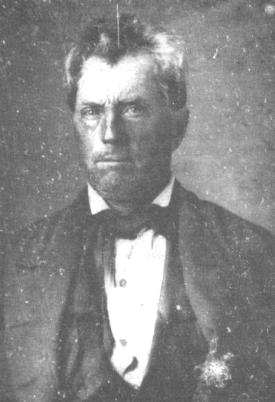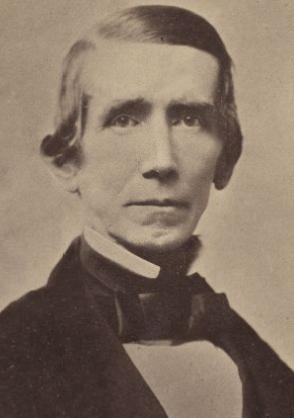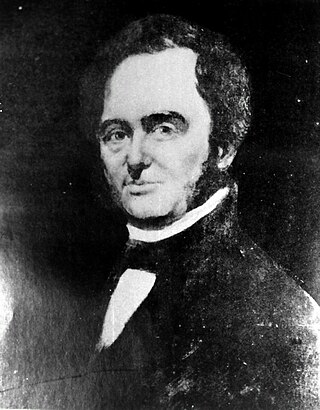Related Research Articles

The Republic of Texas, or simply Texas, was a sovereign state in North America that existed from March 2, 1836, to February 19, 1846. It shared borders with Mexico, the Republic of the Rio Grande, and the United States of America.

David Crockett was an American folk hero, frontiersman, soldier, and politician. He is often referred to in popular culture as the "King of the Wild Frontier". He represented Tennessee in the U.S. House of Representatives and served in the Texas Revolution.

Mirabeau Buonaparte Lamar was an American attorney, politician, poet, and leading political figure during the Texas Republic era. He was elected as the second president of the Republic of Texas after Sam Houston. He was known for waging war against bands of Cherokee and Comanche peoples to push them out of Texas, and for establishing a fund to support public education.

Edward Murray Burleson was the third vice president of the Republic of Texas. After Texas was annexed to the United States, he served in the State Senate. Prior to his government service in Texas, he was a commander of Texian Army forces during the Texas Revolution. Before moving to Texas, he served in militias in Alabama, Missouri, and Tennessee, and fought in the War of 1812. Burleson was the soldier who was given Santa Anna's sword when he surrendered.

The flag of Texas is the official flag of the U.S. state of Texas. It is well known for its prominent single white star which gives the flag its commonly-used name: "Lone Star Flag". This lone star, in turn, gives rise to the state's nickname: "The Lone Star State". The flag, flown at homes and businesses statewide, is highly popular among Texans and is treated with a great degree of reverence and esteem within Texas. Along with the flag of Hawaii, it is one of two state flags to have previously served as a national flag of an independent country. In 2001, the North American Vexillological Association surveyed its members on the designs of the 72 U.S. state, territorial, and Canadian provincial flags and ranked the Texas flag second, behind New Mexico.

Washington-on-the-Brazos is an unincorporated community along the Brazos River in Washington County, Texas, United States. The town is best known for being the site of the Convention of 1836 and the signing of the Texas Declaration of Independence.

The Battle of the Alamo was a pivotal event and military engagement in the Texas Revolution. Following a 13-day siege, Mexican troops under President General Antonio López de Santa Anna reclaimed the Alamo Mission near San Antonio de Béxar, killing most of the occupants. Santa Anna's refusal to take prisoners during the battle inspired many Texians and Tejanos to join the Texian Army. Motivated by a desire for revenge, as well as their written desire to preserve a border open to immigration and the importation and practice of slavery, the Texians defeated the Mexican Army at the Battle of San Jacinto, on April 21, 1836, ending the conquering of the Mexican state of Coahuila y Tejas by the newly formed Republic of Texas.

James Pinckney Henderson was an American and Republic of Texas lawyer, politician, and soldier, and the first governor of the State of Texas.

The North American Aviation T-6 Texan is an American single-engined advanced trainer aircraft used to train pilots of the United States Army Air Forces (USAAF), United States Navy, Royal Air Force, Royal Canadian Air Force and other air forces of the British Commonwealth during World War II and into the 1970s. Designed by North American Aviation, the T-6 is known by a variety of designations depending on the model and operating air force. The United States Army Air Corps (USAAC) and USAAF designated it as the AT-6, the United States Navy the SNJ, and British Commonwealth air forces the Harvard, the name by which it is best known outside the US. Starting in 1948, the new United States Air Force (USAF) designated it the T-6, with the USN following in 1962. It remains a popular warbird used for airshow demonstrations and static displays. It has also been used many times to simulate various historical aircraft, including the Japanese Mitsubishi A6M Zero. A total of 15,495 T-6s of all variants were built.

Moses Austin was an American businessman and pioneer who played a large part in the development of the lead industry in the early United States, especially in southwest Virginia and Missouri. He was the father of Stephen F. Austin, one of the earliest American settlers of Texas, which was at the time part of Mexico.

Manuel Lorenzo Justiniano de Zavala y Sánchez, known simply as Lorenzo de Zavala, was a Mexican and later Tejano physician, politician, diplomat and author. Born in Yucatán under Spanish rule, he was closely involved in drafting the constitution for the First Federal Republic of Mexico in 1824 after Mexico won independence from Spain. Years later, he also helped in drafting a constitution for Mexico's rebellious enemy at the time, the Republic of Texas, to secure independence from Mexico in 1836. Zavala was said to have had a keen intellect and was fluent in multiple languages.

The Republic of the Rio Grande was one of a series of independence movements in Mexico against the unitary government dominated by Antonio López de Santa Anna, including the Republic of Texas, and the second Republic of Yucatán. Insurgents fighting against the Centralist Republic of Mexico sought to establish the Republic of the Rio Grande as an independent nation in Northern Mexico. The rebellion lasted from 17 January to 6 November 1840.

Jerome Bonaparte Robertson was a medical doctor, fighter in conflics with Native Americans, Texas politician, and a general in the Confederate States Army during the American Civil War. He was noted for his service in the famed Texas Brigade in the Army of Northern Virginia.
The Texas Military Forces (TXMF) are the principal instrument through which the Texas Military Department (TMD) executes security policy for Texas, which has the second-largest population and border in the United States.

Antonio de Padua María Severino López de Santa Anna y Pérez de Lebrón, usually known as Antonio López de Santa Anna, or just Santa Anna, was a Mexican soldier, politician, and caudillo who served as the 8th president of Mexico multiple times between 1833 and 1855. He also served as Vice President of Mexico from 1837 to 1839. He was a controversial and pivotal figure in Mexican politics during the 19th century, to the point that he has been called an "uncrowned monarch", and historians often refer to the three decades after Mexican independence as the "Age of Santa Anna".
Richard Franklin Bache, also known as Richard Bache Jr. (1784–1848), was a military and political official in the Republic and state of Texas. He assisted in drafting the Texas Constitution of 1845, the first of its five state constitutions.
Sterling Clack Robertson (1785–1842) was an empresario from Tennessee, during Mexican Texas. He introduced 600 families into Robertson's Colony. Robertson was also an elected delegate to the Washington-on-the-Brazos convention, signing both the Texas Declaration of Independence and the Constitution of the Republic of Texas. He became a senator during the first two sessions of the Congress of the Republic of Texas.

The 1838 Republic of Texas presidential election was the second presidential election. It was held on September 3, 1838. By a provision of the constitution, the term of office of the first president was limited to two years, without his being eligible for re-election; succeeding presidents were to hold their office for three years.

The Texas Army, officially the Army of the Republic of Texas, was the land warfare branch of the Texas Military Forces during the Republic of Texas. It descended from the Texian Army, which was established in October 1835 to fight for independence from Centralist Republic of Mexico in the Texas Revolution. The Texas Army was provisionally formed by the Consultation in November 1835; however, it did not replace the Texian Army until after the Battle of San Jacinto. The Texas Army, Texas Navy, and Texas Militia were officially established on September 5, 1836, in Article II of the Constitution of the Republic of Texas. The Texas Army and Texas Navy were merged with the United States Armed Forces on February 19, 1846, after the Republic of Texas became the 28th state of America.
References
- 1 2 "Sons of the Republic of Texas". Handbook of Texas Online . Texas State Historical Association. June 15, 2010. Retrieved March 24, 2018.